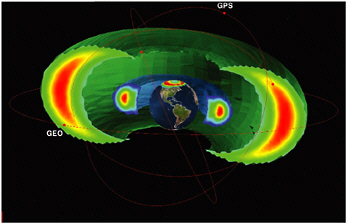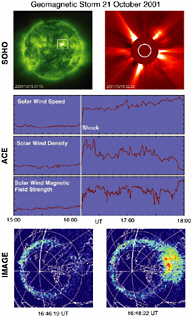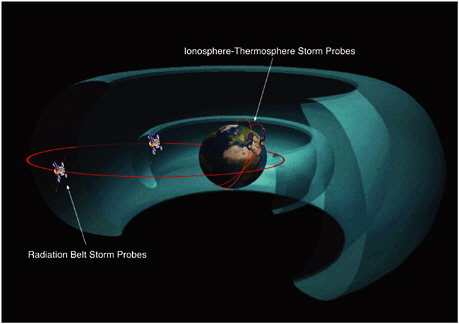STORMS IN SPACE
SPACE WEATHER
Although Earth’s magnetic shield protects our planet from direct exposure to the solar wind, strong variations in the solar wind drive major changes in Earth’s space environment. The largest, most powerful disturbances in the geospace environment are known as magnetic storms, which are triggered by fast CMEs and, during the declining phase of the solar cycle, by high-speed solar wind streams. Magnetic storms are accompanied by dramatic auroral displays, increases in the flux of energetic particles surrounding Earth, and ionospheric disturbances. Like severe weather in Earth’s lower atmosphere, severe magnetic storms can adversely affect human activities. Indeed, as society becomes increasingly dependent on space-based technologies, our vulnerability to space weather becomes more obvious, and the need to understand it and mitigate its effects becomes more urgent.
As magnetic storms rage through the magnetosphere, charged particles can be trapped and dramatically accelerated in Earth’s magnetic field, enhancing the intense belts of extremely energetic radiation encircling Earth. These are the Van Allen radiation belts, whose discovery in 1958 was one of the first great accomplishments of the space age. The radiation belts show fascinating and puzzling variations over a tremendous range of time scales, from microseconds to years. Electrons in the radiation belts, accelerated to velocities approaching the speed of light, are of special interest because these particles can damage spacecraft electronics and present a serious radiation hazard to astronauts on board the International Space Station.
Because the magnetosphere and the ionosphere are electrically coupled, disturbances in the magnetosphere also affect Earth’s upper atmosphere. As noted in the preceding section, storm-time disturbances in the ionosphere can interfere with high-frequency radio communication and navigation signals from GPS satellites. Electrical currents flowing high up in the ionosphere can generate induced currents in power transmission lines and transformers on the ground, potentially causing serious disruption

Model-generated image of Earth’s radiation belts, showing the inner proton belt and the outer electron belt, along with representative orbits for Global Positioning System (GPS) and geosynchronous (GEO) satellites.
of power service as happened in Quebec during the major magnetic storm of March 1989. Even the neutral atmosphere is affected by space storms. Magnetic-storm-induced heating of the thermosphere changes its density and perturbs the orbits of satellites and space debris in low Earth orbit by increasing drag, thereby interfering with orbital tracking and prediction by ground stations.
NASA’s new Exploration Initiative envisions sending astronauts to a Moon base and on extended journeys through space and perhaps to Mars. Astronauts on future lunar and planetary missions will face a serious hazard in the form of episodic energetic solar particle events and ongoing galactic cosmic-ray fluxes, which may impose limitations on what astronauts can undertake. Solar flares spit out particles, sometimes with velocities approaching the speed of light. Fast CMEs drive powerful shock waves in front of them, which accelerate solar wind ions to energies high enough to penetrate a space suit or the hull of a spacecraft. All these fast particles rush outward along the magnetic fields in interplanetary space, engulfing Earth, the Moon, and Mars in a matter of minutes. They can provide a lethal dose of radiation. An astronaut needs to know when such bursts of fast particles are expected so as not to venture too far from the shelter provided in the center of a spacecraft or in a lunar or martian base. In addition to this transient hazard, there is the continuing exposure to galactic cosmic rays, month after month, which can accumulate to levels damaging to long-term health. The astronaut can be shielded from galactic cosmic rays only in a deep underground bunker on the Moon or Mars.
Protecting technological systems and astronauts against space weather requires both timely knowledge of current conditions in space and the ability to forecast space weather disturbances with adequate advance notice. Successful forecasting, in turn, requires an understanding of the basic physical processes at work in space weather. A framework for developing this understanding and the desired “now casting” and forecasting capabilities is provided by the U.S. National Space Weather Program, a multiagency program
formed in 1995 to coordinate the space weather activities of the various government agencies. The Survey Committee strongly recommends continued support for this important national program.
It also recommends deployment of a Solar Wind Monitor upstream of Earth and, as the second-highest priority in the “moderate missions” category, development of the radiation belt and ionosphere-thermosphere probes envisioned as part of the Geospace Missions Network of NASA’s Living With a Star (LWS) program. The LWS program sponsors basic research targeted at the specific regions of space and the physical processes most relevant to our understanding of space weather.

The genesis of a geomagnetic storm. An X-class flare (upper left) and associated coronal mass ejection (CME) were observed by the SOHO spacecraft early on October 19, 2001. The ACE spacecraft, stationed 1.5 million kilometers upstream from Earth, detected the interplanetary shock driven by the CME 2.5 days later, at 16:15 UT on October 21. (The sharp rise in the solar wind speed, density, and magnetic field strength seen in the middle panels indicates the shock’s passage.) About half an hour later, the shock slammed into Earth’s magnetic field, triggering the bright proton auroral flash over northern Canada observed by the IMAGE spacecraft (bottom right) and initiating a geomagnetic storm, which reached its most intense levels on October 21 and 22.
|
MONITORING THE SOLAR WIND Knowing solar wind conditions upstream from Earth is important both for scientific research and for space weather forecasting. At present, this vital information is provided by the Advanced Composition Explorer (ACE) and the Wind spacecraft. However, both spacecraft are now operating considerably beyond their planned lifetimes. The Survey Committee stresses the importance of continued solar wind monitoring after these missions are no longer operating, and it recommends that the National Oceanic and Atmospheric Administration (NOAA) assume responsibility for the deployment and operation of a new Solar Wind Monitor. Positioned 1.5 million kilometers upstream from Earth, at the Lagrangian point L1 (the point where the Sun’s gravity is balanced by Earth’s), the Solar Wind Monitor could provide roughly an hour’s advance warning of changes in the solar wind. |





